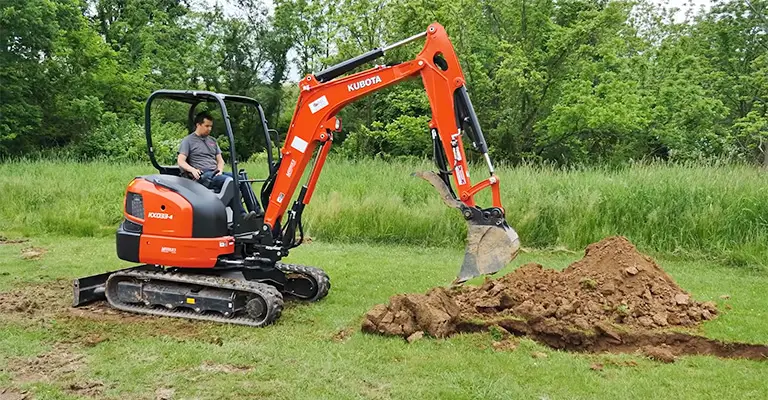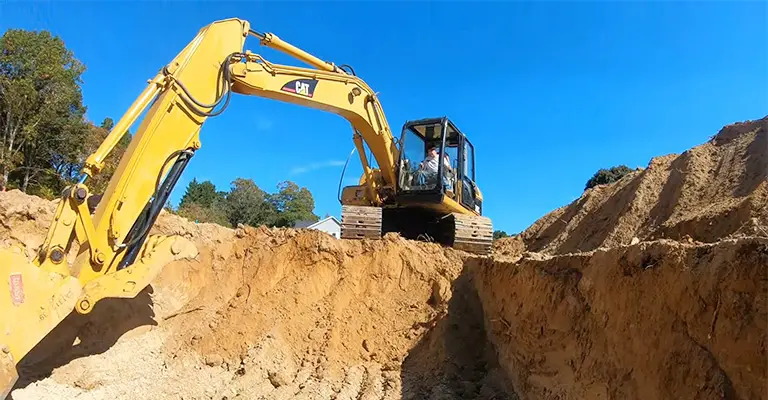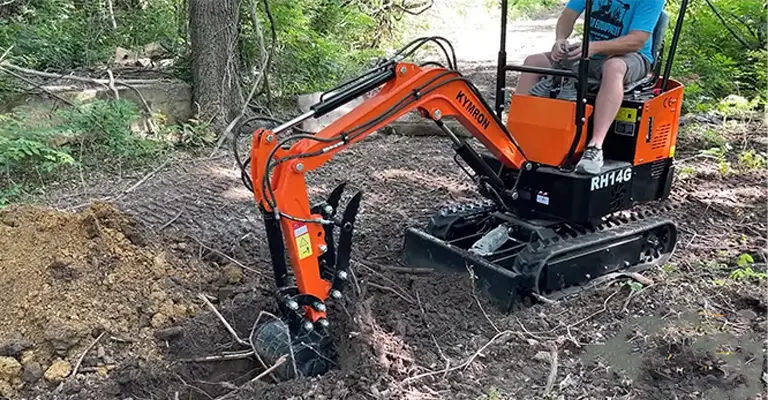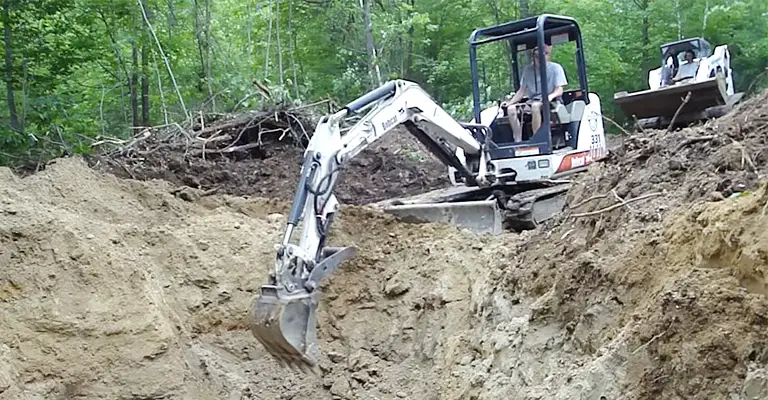In the world of construction and landscaping, the ability to excavate with precision and efficiency is paramount.
Large excavators have long been the go-to option for digging deep into the earth, but the game has changed with the advent of mini excavators.
These compact powerhouses are gaining popularity for their versatility, maneuverability, and ability to tackle various excavation tasks. But just how deep can a mini excavator dig?
How Deep Can a Mini Digger Dig?
It is normal for mini excavators weighing around 1.5 tons to dig a depth of approximately five to six feet.
A mini excavator that weighs 3,000-3,999 pounds can dig a 7.8-foot-deep hole. A 7,000-9,999-pound excavator can dig as deep as 10.2 feet.
A significant figure is usually shown on a mini digger’s specifications page. The depth of the excavation is measured as digging depth.
This specification is right up there with operating weight and engine size, so its importance cannot be denied.

Some models with dipper legs (sometimes called sticks) can reach depths up to 4.2 meters (14 feet) which is sufficient for the majority of excavation applications since utility lines rarely sink higher than 3 meters.
Generally, smaller excavators will dig 2 meters or more, although there are deep-dig models that will dig twice as deep. It is important to note that equipment operators are trained not to push that feature too far.
When this limit is reached, lift power drops, and they know a limit is useless if it means the digger bucket cannot carry out its duties.
Mini Excavator Digging Depth Explained

In addition to their power levels and size, excavators also vary in their depth. The maximum depth of mini electric excavators is only 5 feet, 2 inches.
Mini excavators are more powerful than miniature hydraulic excavators and can reach depths between 7 and 11 feet, 5 inches.
Compared to their larger counterparts, these miniature excavators have low engine power, with the most powerful model coming in at 47 horsepower.
It is crucial to take into consideration how deep the hole needs to be when choosing the size and power of the digger.
As an example, backhoes generally dig 12 to 16 feet deep and are best suited to digging standard projects or holes that aren’t very deep. For foundation digging or excavation of other large, deep spaces, excavators offer a promising alternative.
Hydraulic excavators with close radii take up less space and can dig in confined areas 19 feet, 6 inches or 22 feet, 3 inches deep. Each of these models has 90 horsepower and 55 horsepower.
A hydraulic excavator with a deep digging capacity is the deepest digger available. Furthermore, these have the most horsepower. A 243 HP unit is the most powerful and can dig 26 feet, 7 inches deep.
In all excavators, it is essential to know that the depths listed can change when the stick length is modified.
It is always necessary to verify the specifics before committing to the rental of any digger to ensure the equipment can reach the required depth.
Factors That Affect Mini Excavator Digging Depth

The digging depth of a mini excavator is affected by several factors.
Machine Size And Weight
Its size and weight will profoundly impact the depth of its digging. The smaller the machine, the shallower its digging depth, while the more significant the engine, the deeper its digging depth.
Arm Length
The arm length of a mini excavator also plays a vital role in its depth of digging. The longer arms allow the machine to dig deeper.
Soil Or Material Type
Dipping depths can also be influenced by the soil you want to excavate. In hard, compacted soil or rock, you may have trouble digging deeper than in loose, soft soil, and a mini excavator may be unable to reach these deeper depths.
Job Site Conditions
The conditions of the job site can also affect the depth of the digging. On slopes, for instance, the machine’s maximum depth may be unsafe if it is digging at total capacity.
Is There A Required Ground Condition?
It is essential to assess the ground before hiring a digger. You will need to dig to a depth that matches the condition of your ground when performing this service. Depending on how firm your base is, you may need to dig deeper.
When the soil is firm, a more powerful digger must be used. Moreover, the digging depth should be increased. This project might not be feasible with mini excavators due to their length and weight.
You may need a three-ton excavator if you are digging in sticky or hard soil or if the soil conditions are challenging. Also, instead of the 16kN force of the 1.5-tonne digger, the machine should have the 22kN force of digging in a bucket.
If you want to break or remove surfaces like tarmac or concrete, you can get an attachment for the small excavator. Even the right extension will sometimes add a few inches of digging depth.
Digging Only or Digging and Moving
When deciding on equipment, digging depth is an essential factor to keep in mind, but if a job has a large number of tasks, digging is a relatively insignificant factor.
A digger’s job will not always involve digging. In certain scenarios, digging and moving dirt or rocks around the job site are both required.
In some ways, excavators are better than humans at digging, but they excel at one thing and need assistance for other tasks.
Multi-purpose Cat machines come equipped with many work tools that can easily be swapped out on skid loaders, multi-terrain loaders, backhoes and compact track loaders for use in a wide range of applications.
Skiing loaders, multi-terrain loaders, and compact track loaders are better than backhoes for a job requiring multiple tasks due to their compact size.
Typically, this kind of machine is used on farms and small worksite sites that require digging and grading to create the desired terrain.
In cases where equipment needs multiple attachments, backhoes are the most efficient choice.
The backhoe is perfect for digging and moving dirt if an excavator is too big and skid loaders are too small. Furthermore, it is capable of more horsepower than a skid loader or multi-terrain loader, which offers 74 horsepower at the most.
Backhoes can take advantage of the multitude of attachments with more horsepower. For instance, it is possible to break up asphalt that is scooped up and shifted away by buckets with hammers.
A grapple is useful for clearing out stumps in natural areas for digging or removing tree roots.
Many work tools are available for backhoes, multi-terrain loaders, and other similar equipment that are ideal for projects requiring versatility and preparation.
Don’t Sacrifice Dig Productivity
The equipment’s ability to get around tight building sites takes a hit when you ask it to dig too deep. Deep trenches call for a sizeable articulating steel arm with wide knuckles, and buckets with shallow undersides have difficulty reaching the bottom.
In order to be able to deliver lifting or scraping power down to the bottom of the bucket, the bucket underside should be able to reach down, while the arm knuckle should have a more acute angle.
When either of those requirements is not met, the lifting equipment must be repositioned.
However, you should also consider the drawbacks of a mini digger with an extended digging depth. Performing power-attenuated lifts and checking bucket underside reach/contact limits should never be ignored.
Final Words
If you are planning to construct a foundation, stock tank, swimming pool, garbage pit, or similar hole, you will need an excavator. Ensure you know how deep a mini excavator can dig before renting one.
A project involving digging deep may call for an excavator to handle the work. They will have larger arms, a larger bucket, and higher operating weights for the job.








